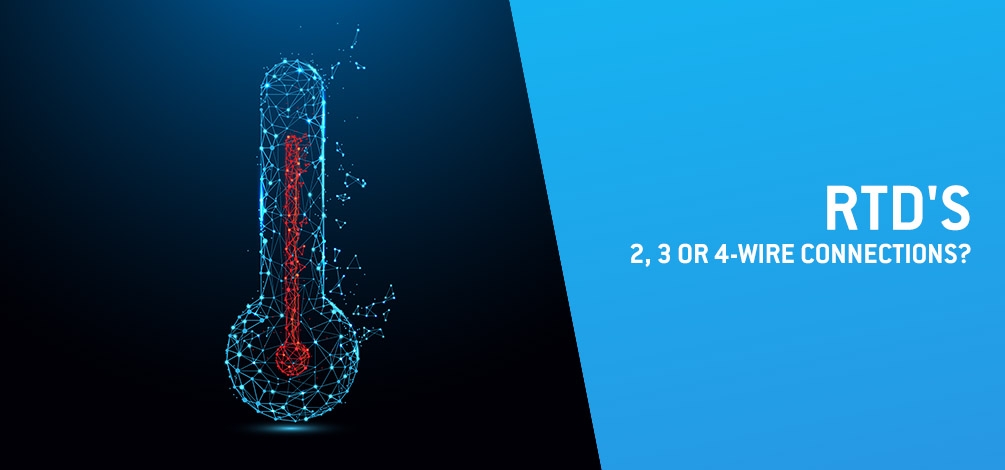RTD'S - 2, 3 OR 4-WIRE CONNECTIONS?

RTD’s are extremely useful instruments for process temperature measurement. The accuracy/temperature range ratio drives its use in singular business areas, from less demanding to more rigorous processes.
RTD means Resistance Temperature Detectors, also known in their application environments as resistance thermometers. The operation of this temperature measurement system is supported by the physical relationship between metal and temperature. The temperature oscillation of a metal is proportionally related to the variation of the metal’s resistance to electric flow. Similarly, as the RTD resistance element temperature increases, the electrical resistance, measured in ohms, decreases.
Traditional RTD’s are manufactured with a small coil of platinum, copper or nickel wire wrapped around a precise strength value around a ceramic or glass coil. Recently, RTDs are also being manufactured using a thin film of platinum metal or nickel iron placed on a ceramic substrate and then laser cut to obtain the desired reference strength. The most evident advantage in this construction is that thin film elements can achieve higher strength with less metal and less space. This makes them smaller, cheaper and more thermally dynamic than traditional elements.
The strength of the materials used has direct influence on the temperature measurement range. The different compounds offer operating ranges with different ranges.

Figure 1 - Temperature range of RTD materials
RTD CONNECTION CONFIGURATION
RTD connections are made in three different ways: 2, 3 or 4 wires.
Choosing the most appropriated configuration is a rigorous process that involves considering several factors that can lead to significant errors throughout the temperature measurement process.

Figure 2 - RTD connections diagram
2-wire connection
The 2-wire connection is the simplest of all. The circuit has no mechanism to counterbalance, delete or calculate conductor resistance. The accuracy of this connection is much lower when compared to 3 or 4 wire connections. The application of this solution is suitable for projects where the length of the connecting wires is necessarily short and where there is no need to perform a measurement with a high degree of accuracy.
3-wire connection
RTDs with 3-wire connections are the most used of the 3 solutions presented. The presence of an additional wire in relation to the above system is precisely to fill the main flaw it has…remove the resistance of the sensor measurement cable. This setting provides a compensation loop that can be used to remove the resistance from the measurement cable.
4-wire connection
The need to choose this type of connection is due to the accuracy required in the temperature measurement process. It is the most complex solution to install and therefore the costliest. In this system, a pair of wires (white and red) are used to carry the excitation current to the sensor and the remaining two wires to measure the ohmic value of the RTD. Since the latter two do not carry the excitation current responsible for introducing errors associated with wire resistance, the actual resistance of each wire can be eliminated by returning the measurement system to the exact resistance of the RTD sensor.
RTD’s CLASSIFICATION
The RTD classification has a direct involvement with their error tolerance at the time of their production. Parameter normalization allows manufacturers to develop solutions that ensure widespread operation.
Within the context of RTD’s, due to their physical characteristics, platinum elements have maintained a high level of popularity and number of applications. Internationally defined standards divide these elements into two distinct classes, A and B, with values set at a temperature/tolerance ratio.

Figure 3 – Temperature/tolerance value table for PRTD's by IEC 751
FINAL CONCLUSIONS
RTD’s are extremely useful instruments for process temperature measurement. The accuracy/temperature range ratio drives its use in singular business areas, from less demanding to more rigorous processes. The 2, 3 or 4-wire connection configurations make it possible to distinguish applicability by the process to be monitored. Resistance thermometers guarantee accuracy and stability in temperature measurement from cryogenic processes to metal melting levels.